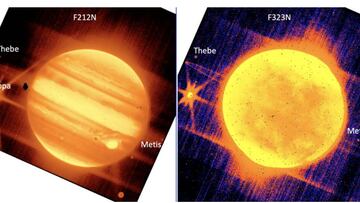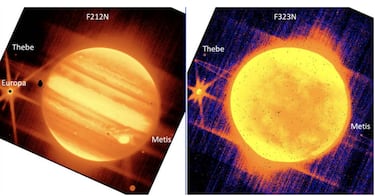James Webb’s stunning image of Jupiter
The most powerful telescope in history captures two images of Jupiter: one with short wavelengths and one with long wavelengths.

The James Webb telescope, the most powerful ever created, never ceases to amaze us. This week the spectacular images were published showing a tiny piece of the distant universe full of galaxies, giant exoplanets and the brightest known nebula, among other elements. The discovery made the front pages of many newspapers and even Coldplay put the images while they sang ‘A Sky Full of Stars’ at a concert in Berlin.
Jupiter seen like never before thanks to James Webb
The latest protagonist is the planet Jupiter, which has crept into the early telescope photos. Specifically, two new photos of Jupiter have been published, in which its moons - Europa, Thebes and Metis - also appear. There are two images: one showing the short wavelength version (left) and the other the long wavelength (right).
The bright snapshots of the gas giant were taken by the telescope’s near-infrared camera NIRCam as it tried to test whether James Webb was capable of tracking fast-moving objects in our own solar system. The report states that the images “demonstrated that JWST can track moving targets even when there is scattered light from a bright Jovian planet.”

NASA chose nine targets to test the telescope's ability to track fast-moving objects, which move at speeds of up to 67 milliarcseconds per second. Jupiter was the slowest target, moving only 3.3 milliarcseconds per second, but all tests were successful. These images also demonstrate its ability to capture details such as rings and moons around bright planets.
(*A milliarcsecond is a unit of angle equal to one thousandth of an arcsecond, used especially in astronomy)
These images are designed for engineering purposes, so they aren’t processed in the same way as our first images this week. Like some earlier calibration images, these are processed to emphasize certain features. pic.twitter.com/t1tSXyscrM
— NASA Webb Telescope (@NASAWebb) July 14, 2022
“Fully capable of achieving the discoveries for which it was built”
Related stories
“Observing a bright planet, with its satellites and rings, was expected to be a challenge, due to scattered light that can affect the science instrument used, but also the fine guidance sensor must track guide stars near the planet. brilliant”, indicates the commissioning report of the James Webb.
“The key result of six months of commissioning is this: JWST is fully capable of achieving the discoveries for which it was built. It was conceived to enable fundamental advances in our understanding of the formation and evolution of galaxies, stars and planetary systems -they point out-. Now we know for sure that it will,” they celebrate in the report.

